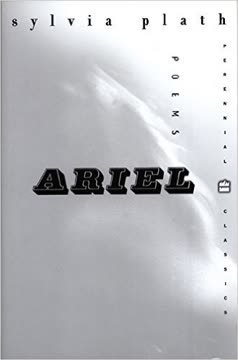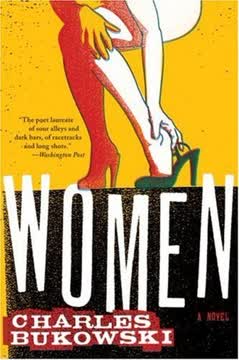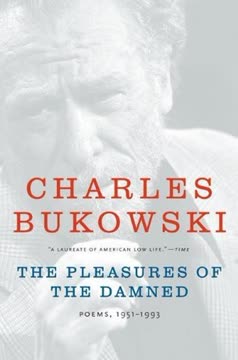Plot Summary
Storms, Wagner, and Survival
Bukowski opens with a meditation on Wagner's music, the storm outside, and the raw, trembling energy of existence. The world shakes, shivers, and bends under the weight of both natural and emotional storms. Wagner's forceful sound becomes a metaphor for the struggle to break through life's barriers, to feel alive even as the world seems small and mean. Bukowski observes that some men never die, some never live, but on nights like this, everyone is alive, if only for a moment. The storm, the music, and the wine intermingle, setting the tone for a book that will be about survival, endurance, and the fleeting moments of connection that make life bearable.
Fathers, Failures, and Food
Bukowski's relationship with his father is a recurring wound. His father obsesses over food and retirement, but dies suddenly, never reaching his dreams. The poet's own childhood is marked by his father's harsh sayings and lack of understanding, leading Bukowski to define himself in opposition: if being a "bum" is the opposite of his father, then that's what he'll be. School is no better—Bukowski struggles with simple words, feels alienated, and is shamed by teachers and parents alike. These early failures and disappointments shape his worldview, teaching him that happiness is elusive, authority is often cruel, and survival means finding your own way.
The Impossible Human Condition
Bukowski surveys the fates of great artists—Van Gogh, Hemingway, Plath, Dostoevsky—and finds a common thread: the impossibility of being human. Genius and madness, creation and destruction, are intertwined. The world is full of punks, cowards, champions, and mad dogs of glory, all moving a little bit of light toward us, impossibly. The poet sees himself as part of this lineage, struggling with the same demons, aware that the act of breathing in and out is itself a kind of victory. The impossibility of being human is both a curse and a source of dark humor.
Trashcan Lives and Democracy
Bukowski reflects on the lives of the marginalized—those on "the row," the forgotten, the derelicts. He notes that in both democracies and dictatorships, the poor are either enslaved, destroyed, or simply forgotten. Everything is owned, everything is locked, and the wind blows cold for those left outside. The poet's empathy for these lives is clear, but so is his sense of resignation: this is the way the world works, and the only solace is a bottle of red and the company of others who understand.
The Lost Generation's Toys
Reading about the literary elite of the 1920s, Bukowski is struck by their self-importance and the way true artists become "precious toys" for the rich. He is disgusted by the snobbery and the emptiness of their lives, even as he acknowledges their talent. The poet's own brushes with fame and the literary world leave him cold; he prefers the company of outsiders and the authenticity of struggle. The lesson is clear: art is often corrupted by money and status, and true connection is rare.
The Unfillable Heart
Bukowski writes of a place in the heart that will never be filled, a space that persists even in the best moments. This emptiness is universal, and the poet suggests that we will wait and wait in that space, knowing it more than ever during our greatest times. The ache of longing, the knowledge that something is always missing, becomes a central theme—a kind of existential wound that shapes all human experience.
Lessons from the Assembly Line
Bukowski criticizes poets who have never worked an eight-hour job, arguing that real work puts you in touch with reality. Most poets, he claims, are protected by family and write words that are unlived and untrue. The poet's own experience in factories and menial jobs gives his writing a raw authenticity. He sees poetry as something that must be earned through suffering and endurance, not handed down from ivory towers.
Downtown L.A. Nights
A night in downtown Los Angeles becomes a microcosm of Bukowski's world: smashed windows, whiskey, a hard woman, and the possibility of connection. The poet finds beauty in the ruined, sees the flower beneath the scars, and chooses not to exploit the woman he's with. Instead, they share drinks, stories, and laughter, finding peace in their mutual brokenness. The city listens, and for a moment, there is hope.
Cats, Companions, and Sanity
Bukowski's cats are his true companions—uncomplicated, nonjudgmental, and content. In the early morning hours, as the world sleeps, the poet finds sanity in their presence. They listen to the same music, never argue, and never vote for a president. The simplicity of their lives offers a contrast to the chaos of human relationships. The poet's bond with his cats becomes a symbol of the small, quiet joys that make life bearable.
The Writer's Curse
Bukowski recounts his years as a starving writer, sending stories to major magazines and collecting rejection slips. Hunger, poverty, and loneliness are constant companions, but so is the compulsion to write. Even when he gives up on writing and turns to drinking, the urge to create never leaves him. The poet sees himself as cursed and blessed by this drive, aware that the price of creation is never too high, but the price of living with others often is.
Love, Loss, and Fleas
Bukowski's love life is a parade of failed relationships, betrayals, and fleeting pleasures. He is drawn to damaged women, finds solace in brief connections, and is often left alone with his thoughts and his cats. The absurdity of desire is highlighted in stories of women who bring him pain, lovers who leave him with fleas, and the endless search for something real. The poet's honesty about his own failings and needs is both brutal and tender.
The Freeway and Fate
Life on the freeway becomes a metaphor for the randomness and danger of existence. Bukowski describes near-misses, breakdowns, and the courage it takes to get out of bed each morning. Defeat can strengthen, victory can weaken, and sometimes survival is a matter of luck and endurance. The poet's willingness to face the same things over and over, to keep moving despite setbacks, becomes a quiet act of heroism.
Drinking, Writing, Enduring
Bukowski finds meaning in the act of writing while drunk, claiming it beats being with any woman he's ever known. The camaraderie of old writers, the endurance required to keep creating, and the solace found in the bottle are recurring motifs. The poet acknowledges the toll this life takes—on health, relationships, and sanity—but insists that the magic of creation is worth the price. The old dogs keep fighting, and so does he.
The Old Dogs' Fight
As Bukowski ages, he feels talent slipping away, hears others celebrating his demise, and drinks alone at his malfunctioning machine. Yet he refuses to give up, lighting new cigarettes, pouring more drinks, and fighting the slow retreat. The beauty is in the fight itself, in the refusal to surrender, and in the small victories that come from enduring. The poet's acceptance of aging and decline is tempered by a fierce pride in having survived.
Fame, Failure, and Felines
Fame brings little satisfaction—Bukowski is now a "supposedly famous" writer, but finds more comfort in his five cats than in the accolades of the literary world. The people he once admired have dissolved, but his cats remain, as does his wife. The poet reflects on the fleeting nature of success, the inevitability of death, and the small joys that persist. Fame is the last whore, and he is not sad for the dead or the living, only for the loss of authenticity.
The Magic of Small Moments
Bukowski celebrates the small, quiet moments that make life worthwhile: scratching your neck while looking out the window, pouring a glass of water, sitting with a cat. These moments of peace, the "space before they get to us," are worth centuries of existence. The poet finds magic in the ordinary, solace in solitude, and meaning in the act of simply being. The lesson is to cherish these moments, for they are all we truly have.
Endings, Bombs, and Beginnings
As the book draws to a close, Bukowski contemplates death, the threat of nuclear annihilation, and the end of all things. He is tired of waiting, tired of the fix, and ready to let the bombs blow. Yet even in the face of destruction, there is a sense of acceptance—a recognition that life is a series of endings and beginnings, and that the only real victory is to keep going, to keep creating, and to walk through the fire as best you can.
How Well You Walk Through Fire
The book ends with a meditation on resilience: what matters most is how well you walk through the fire. Bukowski's life has been marked by suffering, failure, and loss, but also by endurance, creativity, and moments of joy. The final lesson is not to avoid pain or seek happiness, but to accept the struggle, find balance, and keep moving forward. The poet's voice is weary but unbroken, offering a hard-won wisdom to those willing to listen.
Characters
Charles Bukowski (Hank Chinaski)
Bukowski, writing as his alter ego Hank Chinaski, is the central figure—an aging poet and chronic outsider. He is fiercely independent, deeply skeptical of authority, and haunted by childhood trauma. His relationships are fraught, his work history checkered, and his love life a series of disasters. Yet beneath the cynicism and bravado lies a profound empathy for the marginalized and a relentless drive to create. Bukowski's psychological landscape is shaped by loneliness, addiction, and a longing for authenticity. Over the course of the book, he moves from anger and alienation toward a grudging acceptance of himself and the world, finding solace in small pleasures and the act of writing.
The Father
Bukowski's father is a looming presence—demanding, critical, and emotionally distant. His obsession with success and survival leaves little room for affection or understanding. The father's death is sudden and unceremonious, mirroring the abruptness with which he shaped and scarred his son. The psychological impact is lasting: Bukowski's rebellion, self-definition, and sense of failure are all rooted in this fraught relationship.
The Mother
Bukowski's mother is a quieter figure, often caught between her husband's harshness and her son's struggles. She is depicted as powerless, weeping in the face of her son's failures and her husband's disappointment. Her inability to protect or support Bukowski contributes to his sense of isolation and mistrust of authority.
Jane
Jane is one of Bukowski's most significant lovers—a fellow drinker and outcast. Their relationship is marked by poverty, chaos, and moments of wild joy. Jane's eventual death leaves Bukowski adrift, mourning not just her loss but the loss of a time when life, for all its hardship, felt vivid and real. Jane embodies the theme of love as both salvation and destruction.
The Cats
Bukowski's cats—Ting, Ding, Beeker, Bleeker, Blob—are more than pets; they are symbols of the uncomplicated companionship and sanity he craves. Their presence offers comfort, routine, and a sense of home. The cats' indifference to human concerns highlights the absurdity of much human striving and provides a counterpoint to the chaos of Bukowski's relationships.
The Women
The women in Bukowski's life are a parade of lovers, strippers, and fleeting encounters. They are often damaged, sometimes cruel, and always temporary. Bukowski's relationships with them are marked by longing, disappointment, and the search for connection. The women serve as mirrors for his own wounds and as reminders of the impossibility of lasting happiness.
The Old Dogs (Fellow Writers)
Bukowski's fellow writers are depicted as survivors—men who have endured wars, failed marriages, and obscurity, yet continue to write. They are both rivals and comrades, united by their endurance and their refusal to give up. The old dogs represent the possibility of improvement and the value of persistence in the face of decline.
The City (Los Angeles)
Los Angeles is more than a setting; it is a character in its own right. The city's streets, bars, hotels, and freeways are the stage for Bukowski's struggles and triumphs. The city is both a source of inspiration and a symbol of alienation—a place where dreams are made and broken.
The Literary World
The world of editors, critics, and literary elites is depicted as insular, self-important, and disconnected from real life. Bukowski's interactions with this world are marked by rejection, resentment, and a sense of being an outsider. The literary world serves as a foil to Bukowski's authenticity and as a reminder of the compromises required for success.
The Dead Artists
Van Gogh, Hemingway, Plath, and others appear as ghosts and inspirations. Their struggles with madness, poverty, and death are both warnings and sources of kinship for Bukowski. The dead artists embody the impossibility of being human and the price of creation.
Plot Devices
Episodic, Fragmented Narrative
Bukowski's book is structured as a series of loosely connected vignettes, poems, and reflections. There is no linear plot; instead, the narrative moves back and forth in time, shifting between childhood memories, adult experiences, and philosophical musings. This fragmented structure mirrors the chaos of Bukowski's life and the unpredictability of existence. The lack of traditional plot allows for a raw, unfiltered exploration of themes and emotions.
Repetition and Recurrence
Certain motifs—alcohol, cats, failed relationships, rejection, the act of writing—recur throughout the book, creating a sense of continuity amid the fragmentation. These repetitions reinforce the central themes of endurance, loneliness, and the search for meaning. The recurrence of specific images (the bottle, the typewriter, the freeway) serves as anchors in the poet's turbulent world.
Juxtaposition of Humor and Despair
Bukowski frequently uses humor to undercut despair, finding absurdity in suffering and laughter in pain. This juxtaposition allows the poet to confront difficult truths without succumbing to self-pity. The humor is often dark, self-deprecating, and laced with irony, providing relief and insight in equal measure.
Direct Address and Meta-Commentary
Bukowski often addresses the reader directly, commenting on his own writing, the expectations of his audience, and the futility of literary ambition. This meta-commentary creates intimacy and immediacy, drawing the reader into the poet's world and inviting them to share in his struggles and insights.
Symbolism of Animals and Objects
Animals, especially cats, serve as symbols of peace, independence, and the possibility of contentment. Objects like the bottle and the typewriter represent both the tools of survival and the sources of addiction and compulsion. These symbols ground the poet's abstract meditations in concrete reality.
Analysis
You Get So Alone at Times That It Just Makes Sense is Bukowski's raw, unvarnished testament to the human condition. Through a collage of poems and vignettes, he explores the pain of childhood, the failures of love, the grind of work, and the compulsion to create. The book is a celebration of endurance in the face of suffering, a rejection of pretense and snobbery, and an embrace of the small moments that make life bearable. Bukowski's voice is both brutal and tender, laced with dark humor and hard-won wisdom. The central lesson is not to seek happiness or avoid pain, but to accept the struggle, cherish the fleeting joys, and walk through the fire with as much grace as you can muster. In a world that is often cold, indifferent, and absurd, Bukowski finds meaning in authenticity, resilience, and the simple act of continuing.
Last updated:
FAQ
```markdown
Q&A on "The Captain is Out to Lunch and the Sailors Have Taken Over the Ship" by Charles Bukowski
What is the main theme of the book?
The main theme of "The Captain is Out to Lunch and the Sailors Have Taken Over the Ship" is the struggle of an aging writer to find meaning and purpose in a world that often seems chaotic and indifferent. Bukowski, through his alter ego Hank Chinaski, explores themes of loneliness, creativity, mortality, and the search for authenticity in the face of societal pressures and personal demons.
The book delves into Bukowski's reflections on:
- The writing process and the role of the artist in society
- The challenges of aging and facing one's mortality
- The absurdity of everyday life and human behavior
- The tension between the desire for connection and the need for solitude
- The impact of past traumas and relationships on one's present life
Throughout the book, Bukowski maintains a sardonic, often humorous tone, using dark comedy as a survival mechanism to confront difficult truths about himself and the world around him.
How is the book structured?
The book is structured as a series of loosely connected vignettes, poems, and reflections. There is no traditional linear plot; instead, the narrative moves back and forth in time, shifting between:
- Present-day observations and experiences
- Memories of past events and relationships
- Philosophical musings on life, art, and society
- Brief poetic interludes
This fragmented structure mirrors the chaotic nature of Bukowski's life and thoughts, allowing for a raw, unfiltered exploration of his inner world. The lack of a conventional plot emphasizes the book's focus on the writer's state of mind rather than on specific events or actions.
Bukowski often addresses the reader directly, commenting on his own writing process and the act of creating the book itself. This meta-commentary creates a sense of immediacy and intimacy, as if the reader is privy to the writer's thoughts as they unfold.
Who are the main characters in the book?
As a largely autobiographical work, the main character is Charles Bukowski himself, writing under the persona of Hank Chinaski. Other significant figures include:
- Bukowski's cats - They play a central role in his daily life and serve as a source of comfort and stability.
- Past lovers and relationships - Bukowski reflects on various women he has known, including Jane, a significant past relationship.
- Fellow writers and artists - Both living and dead, they serve as points of comparison and reflection for Bukowski.
- His parents, particularly his father - Memories of his childhood and his relationship with his parents surface throughout the book.
While these characters appear in Bukowski's recollections and musings, the focus remains primarily on the writer himself and his internal experiences.
What role do Bukowski's cats play in the book?
Bukowski's cats play a significant role in the book, serving multiple purposes:
- Companions - They provide Bukowski with companionship and a sense of routine in his otherwise chaotic life.
- Symbols - The cats represent simplicity, contentment, and the possibility of finding peace in small moments.
- Contrast - Their presence highlights the complexity and often absurd nature of human concerns and behaviors.
- Emotional anchor - Bukowski's interactions with his cats offer moments of tenderness and vulnerability, contrasting with his often cynical worldview.
- Writing inspiration - The cats' behaviors and Bukowski's observations of them frequently spark reflections on life, death, and the human condition.
The cats provide a thread of consistency throughout the book, appearing in various vignettes and serving as a grounding presence in Bukowski's life and writing.
How does Bukowski view the literary world and other writers?
Bukowski's perspective on the literary world and other writers is complex and often critical:
- Skepticism - He expresses skepticism towards the literary establishment, viewing it as pretentious and disconnected from real life.
- Authenticity - Bukowski values authenticity in writing and is critical of what he perceives as artificial or overly intellectual approaches to literature.
- Respect for endurance - While critical of many aspects of the literary world, he respects fellow writers who have persevered despite hardships and lack of recognition.
- Ambivalence towards success - He grapples with his own increasing recognition, often expressing discomfort with literary fame and its trappings.
- Inspiration from past artists - Bukowski frequently references and draws inspiration from writers and artists of the past, particularly those who lived troubled lives.
Throughout the book, Bukowski positions himself as an outsider in the literary world, valuing his independence and unique voice over acceptance by the establishment.
What role does alcohol play in the book?
Alcohol plays a significant role in "The Captain is Out to Lunch and the Sailors Have Taken Over the Ship," reflecting its importance in Bukowski's life and work:
- Coping mechanism - Alcohol is portrayed as a way for Bukowski to deal with the challenges of life, including loneliness, anxiety, and the pressures of writing.
- Symbol of rebellion - Drinking represents a form of rebellion against societal norms and expectations.
- Source of inspiration - Bukowski often describes alcohol as fueling his creativity and writing process.
- Destructive force - While romanticizing alcohol to some extent, Bukowski also acknowledges its destructive potential and its role in past relationship failures.
- Ritual and routine - Drinking is presented as a central part of Bukowski's daily routine, providing structure and comfort.
The presence of alcohol in the book is a recurring motif, often serving as a lens through which Bukowski views and interprets his experiences and the world around him.
How does Bukowski address the theme of aging in the book?
The theme of aging is prominent in "The Captain is Out to Lunch and the Sailors Have Taken Over the Ship," as Bukowski reflects on his experiences as an older writer:
- Physical decline - He candidly discusses the physical challenges and limitations that come with aging.
- Mortality - There's an increased awareness of mortality and the passage of time throughout the book.
- Reflection on past - Bukowski frequently looks back on his younger years, comparing his current self to his past experiences.
- Changing perspective - He explores how his worldview and priorities have shifted with age.
- Creative endurance - Despite the challenges of aging, Bukowski emphasizes the importance of continuing to create and find meaning through writing.
- Wisdom and cynicism - The book balances moments of hard-earned wisdom with a persistent cynicism about human nature and society.
Bukowski's approach to aging is characterized by a mix of resignation, defiance, and dark humor, as he grapples with the realities of growing older while maintaining his distinctive voice and perspective.
What is the significance of the book's title?
The title "The Captain is Out to Lunch and the Sailors Have Taken Over the Ship" is metaphorical and reflects several key themes in the book:
- Chaos and lack of control - It suggests a world where traditional authority or order has broken down, mirroring Bukowski's view of society and his own life.
- Absurdity of existence - The title captures the often absurd and unpredictable nature of life that Bukowski frequently explores in his writing.
- Rebellion against authority - It hints at Bukowski's anti-authoritarian stance and his skepticism towards established systems and hierarchies.
- Loss of direction - The image of a ship without its captain can be seen as a metaphor for Bukowski's feelings about aging and facing an uncertain future.
- Creative freedom - In the context of writing, it might suggest the idea of letting go of rigid control and allowing creativity to flow freely.
The playful and slightly anarchic tone of the title also reflects Bukowski's use of humor to address serious themes, a characteristic feature of his writing style.
How does Bukowski portray his relationships with women in the book?
Bukowski's portrayal of his relationships with women in the book is complex and often contradictory:
- Desire and disappointment - He expresses a strong desire for connection with women, but many of his relationships are marked by disappointment and failure.
- Objectification and empathy - While sometimes objectifying women, Bukowski also shows moments of deep empathy and understanding for their struggles.
- Past regrets - He reflects on past relationships, particularly with Jane, with a mix of nostalgia and regret.
- Power dynamics - Bukowski explores the complex power dynamics in his relationships, often portraying himself as both vulnerable and domineering.
- Loneliness and connection - Women are presented as potential escapes from loneliness, but also as sources of emotional turmoil.
- Aging and attraction - He grapples with the challenges of attraction and sexuality as an older man.
Overall, Bukowski's relationships with women are portrayed as intense, fleeting, and often troubled, reflecting his broader themes of alienation and the search for meaning in human connections.
What role does Los Angeles play in the book?
Los Angeles serves as more than just a backdrop in "The Captain is Out to Lunch and the Sailors Have Taken Over the Ship," playing a significant role in shaping Bukowski's experiences and perspectives:
- Setting - The city provides the physical setting for many of Bukowski's observations and experiences.
- Character - Los Angeles is often portrayed as a character in itself, with its own personality and influence on the narrative.
- Symbol of American culture - The city represents broader themes about American society, including its contradictions and excesses.
- Personal history - Bukowski's long history with Los Angeles allows him to reflect on changes in the city and in himself over time.
- Inspiration - The urban landscape and diverse population of Los Angeles serve as constant sources of inspiration for Bukowski's writing.
- Alienation - The sprawling, often impersonal nature of the city reinforces themes of alienation and isolation in Bukowski's work.
Los Angeles is presented as both a source of frustration and fascination for Bukowski, embodying many of the contradictions he explores in his writing.
How does Bukowski view the act of writing in this book?
Bukowski's perspective on the act of writing is a central theme in "The Captain is Out to Lunch and the Sailors Have Taken Over the Ship":
- Necessity - Writing is portrayed as an essential, almost compulsive act for Bukowski, necessary for his survival and sanity.
- Authenticity - He emphasizes the importance of writing honestly and from personal experience, rejecting artificial or overly intellectual approaches.
- Struggle - Bukowski describes the challenges of the writing process, including self-doubt, writer's block, and the pressure of expectations.
- Escape - Writing serves as an escape from the mundane and difficult aspects of life, offering a form of transcendence.
- Identity - Bukowski's identity as a writer is central to his self-conception and his way of interacting with the world.
- Critique of literary world - He often criticizes what he sees as pretension and inauthenticity in the literary world.
- Legacy - As an aging writer, Bukowski reflects on the impact of his work and his place in literary history.
Throughout the book, writing is presented as both a source of torment and salvation for Bukowski, central to his understanding of himself and his place in the world.
What literary techniques does Bukowski employ in this book?
Bukowski employs several distinctive literary techniques in "The Captain is Out to Lunch and the Sailors Have Taken Over the Ship":
- Episodic, fragmented narrative - The book is structured as a series of loosely connected vignettes and reflections rather than a linear narrative.
- Stream of consciousness - Bukowski often writes in a free-flowing style that mimics the natural progression of thoughts and observations.
- Direct address - He frequently addresses the reader directly, creating a sense of intimacy and immediacy.
- Juxtaposition of humor and despair - Bukowski combines dark humor with serious themes, using comedy to address difficult subjects.
- Repetition and recurrence - Certain themes, images, and motifs recur throughout the book, creating a sense of cohesion in the fragmented structure.
- Minimalist style - Bukowski's writing is often spare and direct, avoiding flowery language or complex sentence structures.
- Symbolism - He uses recurring symbols, such as his cats or his typewriter, to represent larger themes.
- Meta-commentary - Bukowski often comments on the act of writing itself, blurring the lines between the work and its creation.
These techniques contribute to the raw, unfiltered quality of Bukowski's writing, reinforcing his themes of authenticity and the immediate experience of life.
How does Bukowski address his own mortality in the book?
Bukowski's confrontation with mortality is a significant theme in "The Captain is Out to Lunch and the Sailors Have Taken Over the Ship":
- Direct acknowledgment - He openly discusses his awareness of aging and the approach of death.
- Reflection on past - Bukowski frequently looks back on his life, evaluating his experiences and choices in light of his limited remaining time.
- Gallows humor - He often uses dark humor to address the topic of death, finding absurdity in the human condition.
- Physical decline - Descriptions of his aging body and health issues serve as constant reminders of mortality.
- Artistic legacy - Bukowski considers the impact of his work and what will remain after he's gone.
- Appreciation of present - There's an increased focus on finding meaning and pleasure in small, everyday moments.
- Comparison with others - He reflects on the deaths of friends, family, and fellow artists, contextualizing his own mortality.
Bukowski's approach to mortality in the book is characterized by a mix of defiance, resignation, and a determination to continue creating despite the looming presence of death.
What is the significance of Bukowski's childhood memories in the book?
Bukowski's childhood memories play a crucial role in "The Captain is Out to Lunch and the Sailors Have Taken Over the Ship":
- Formative experiences - These memories highlight the events and relationships that shaped Bukowski's worldview and personality.
- Relationship with parents - Recollections of his parents, particularly his father, provide insight into Bukowski's complex feelings about authority and family.
- Root of alienation - Childhood experiences of bullying and isolation are presented as the origins of Bukowski's sense of being an outsider.
- Contrast with present - These memories serve as points of comparison with Bukowski's current life, highlighting changes and consistencies in his character.
- Source of writing material - Childhood experiences are mined for their literary potential, becoming part of Bukowski's raw material as a writer.
- Psychological insight - The memories offer glimpses into the psychological foundations of Bukowski's adult behaviors and attitudes.
- Themes of resilience - Recollections of childhood hardships underscore Bukowski's themes of survival and endurance.
By interweaving these memories with his present-day observations, Bukowski creates a rich tapestry that illustrates the continuity of experience and the lasting impact of early life events.
How does Bukowski balance cynicism and hope in the book?
The balance between cynicism and hope is a central tension in "The Captain is Out to Lunch and the Sailors Have Taken Over the Ship":
- Cynical observations - Bukowski frequently offers scathing critiques of society, human behavior, and the literary world.
- Moments of beauty - Despite his cynicism, he finds and appreciates moments of beauty and authenticity in everyday life.
- Persistence in writing - The act of continuing to write despite hardships and disappointments represents a form of hope.
- Relationships with cats - His interactions with his cats offer glimpses of uncomplicated joy and companionship.
- Dark humor - Bukowski uses humor to navigate between despair and resilience, finding absurdity in difficult situations.
- Appreciation of simple pleasures - While cynical about grand ambitions, he finds hope in small, everyday pleasures.
- Artistic integrity - Bukowski's commitment to authentic expression in his work suggests a belief in the value of art despite his skepticism about the world.
This balance reflects Bukowski's complex worldview, acknowledging the harsh realities of life while still finding reasons to continue engaging with the world and creating art.
What role do other writers and artists play in Bukowski's reflections?
Other writers and artists play a significant role in Bukowski's reflections throughout the book:
- Points of comparison - Bukowski often compares himself to other writers, both contemporaries and historical figures.
- Sources of inspiration - He draws inspiration from the lives and works of artists he admires, particularly those who lived troubled or unconventional lives.
- Critique of literary world - Through his observations of other writers, Bukowski offers criticism of what he sees as pretension or inauthenticity in the literary establishment.
- Kinship and rivalry - He expresses both a sense of kinship with fellow outsider artists and a competitive spirit towards his contemporaries.
- Reflection on artistic legacy - Considering the fates of past writers allows Bukowski to contemplate his own potential legacy.
- Exploration of creativity - Reflections on other artists provide a lens through which Bukowski examines the nature of creativity and the challenges of the artistic life.
- Historical context - References to other writers place Bukowski's work within a broader literary and cultural context.
These reflections on other writers and artists help Bukowski define his own artistic identity and explore broader themes about the nature of art and the artist's role in society.
How does the book reflect Bukowski's philosophy of life?
"The Captain is Out to Lunch and the Sailors Have Taken Over the Ship" offers insight into Bukowski's philosophy of life through various themes and reflections:
- Authenticity - Bukowski emphasizes the importance of being true to oneself and one's experiences, rejecting societal pretensions.
- Resilience - The book showcases Bukowski's belief in enduring life's hardships and continuing to create despite obstacles.
- Skepticism - He maintains a skeptical view of authority, institutions, and conventional wisdom.
- Appreciation of simplicity - Bukowski finds value in small pleasures and everyday experiences rather than grand ambitions.
- Acceptance of life's absurdities - He embraces the often chaotic and nonsensical nature of existence.
- Importance of creative expression - Writing is presented as a vital means of engaging with the world and finding meaning.
- Critique of materialism - [Bukowski](#charles-bukowski-
Review Summary
You Get So Alone at Times That it Just Makes Sense is a raw, honest collection of poems by Charles Bukowski. Readers appreciate his brutal honesty, dark humor, and ability to blend crass reality with moments of beauty. The collection explores themes of loneliness, alcoholism, relationships, and the struggles of everyday life. While some find his work vulgar and misogynistic, others praise his unique perspective and poetic style. Many readers connect deeply with Bukowski's observations on human nature and society, finding his work both relatable and thought-provoking.
Similar Books
Download PDF
Download EPUB
.epub digital book format is ideal for reading ebooks on phones, tablets, and e-readers.












